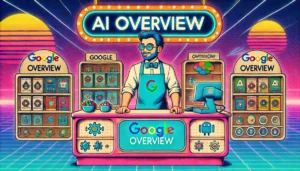How to Transform Your Business for AI: A Practical Guide for 2025
The promise of AI transformation is everywhere. ChatGPT hit 100 million users in just two months, and suddenly every business owner is wondering: “How do I make AI work for my company?” But here’s the reality: Most businesses aren’t ready for AI transformation. Not because they can’t be, but because they’re trying to build AI…
The promise of AI transformation is everywhere. ChatGPT hit 100 million users in just two months, and suddenly every business owner is wondering: “How do I make AI work for my company?”
But here’s the reality: Most businesses aren’t ready for AI transformation. Not because they can’t be, but because they’re trying to build AI capabilities on top of systems and websites that weren’t designed for it. As we’ve seen with recent changes in web traffic patterns, traditional approaches are becoming less effective.
It’s like trying to turn a horse-drawn carriage into a Tesla by strapping on some batteries. Sure, it might move, but it’s not going to give you the experience you’re looking for.
After helping dozens of businesses navigate their AI journey, we’ve learned something crucial: Successful AI transformation isn’t about adding AI tools to your existing business – it’s about rebuilding your foundation to make AI integration natural and effective.
In this guide, we’ll show you how to approach AI transformation the right way, starting with the most critical first step that most businesses skip: assessing your readiness.
Why Traditional Business Systems Need to Change
Think about your current website and business systems. They were likely built for a world where:
- Humans would read every page
- Information flow was one-directional
- Data lived in separate silos
- Content was designed for screens, not AI processing
But in 2025, your systems need to serve two audiences: humans and AI. And they have very different needs, as we’re already seeing with the launch of Google’s Gemini 2.0:
| Humans Need | AI Needs |
|---|---|
| Visual appeal | Clean data structure |
| Intuitive navigation | Efficient token usage |
| Engaging content | Clear content relationships |
| Quick loading | API accessibility |
The gap between these needs explains why simply adding AI tools to existing systems often disappoints. Your AI assistants are fighting against your infrastructure instead of working with it.
The Four Stages of AI Business Transformation
Through our work with businesses across industries, we’ve identified four distinct stages of AI transformation:
Stage 1: Assessment and Planning (You are likely here)
- Understanding your current capabilities
- Identifying quick wins and long-term opportunities
- Creating a realistic transformation roadmap
- Setting clear, measurable goals
This is where the Smart Site Assessment comes in. Think of it as your AI readiness check – a comprehensive evaluation of your current systems, content, and processes to determine your starting point.
Stage 2: Foundation Building
Without a solid foundation, even the most sophisticated AI tools will underperform. This stage focuses on creating AI-ready infrastructure through Smart Sites – websites and systems specifically designed for the AI age.
Key elements of an AI-ready foundation include:
- Structured data architecture
- Clean content organization
- Efficient API endpoints and SEO structure
- Vector-optimized information storage
Think of this as building the electrical system before installing smart home devices. You need the right wiring before anything can work properly.
Stage 3: Integration and Testing
With your foundation in place, you can begin introducing AI capabilities that actually work. Using tools like OneClick AI, you can start:
- Knowledge base development
- Customer service automation
- Content personalization
- Internal process automation
This is where tools like Brain-E come into play, allowing you to:
- Create intelligent knowledge bases
- Build custom AI assistants
- Automate repetitive tasks
- Enable AI-powered customer interactions
Stage 4: Advanced Implementation
The final stage is where transformation really takes hold:
- Custom AI development
- Full system integration
- Advanced automation
- Predictive capabilities
Starting Your Transformation Journey: Common Pitfalls to Avoid
Before you dive in, let’s address the most common mistakes we see businesses make. Many of these echo the lessons learned from early ChatGPT adoption:
Starting with Tools Instead of Strategy
- Wrong: “Let’s add ChatGPT to our website!”
- Right: “Let’s identify where AI can add the most value.”
Skipping the Assessment Phase
- Wrong: “Our site works fine, let’s just add AI.”
- Right: “Let’s understand our current capabilities and gaps.”
Underestimating Infrastructure Needs
- Wrong: “We can build on our existing systems.”
- Right: “We need to prepare our systems for AI integration.”
Focusing on Features Instead of Value
- Wrong: “We need an AI chatbot because competitors have one.”
- Right: “We need to solve specific business problems with AI.”
The Smart Site Assessment: Your AI Readiness Check
Before you can transform your business with AI, you need to know where you stand. The Smart Site Assessment (what we call our Operator Optimizer) evaluates five critical areas that determine your AI readiness:
1. Technical Infrastructure
We analyze your current website and systems for:
- Page load speeds and performance
- Data structure and organization
- API capabilities and limitations
- Content delivery methods
- Security protocols
Why this matters: As we’ve seen with recent changes in search technology, AI systems need clean, structured data and efficient access points. Your current technical setup might be creating unnecessary barriers.
2. Content Architecture
We examine how your content is:
- Organized and structured
- Tagged and categorized
- Interlinked and related
- Stored and delivered
- Updated and maintained
Why this matters: AI systems process information differently than humans. Poor content architecture can lead to increased costs and reduced effectiveness of AI tools.
3. Data Flow Analysis
We map out how information moves through your business:
- Customer interaction points
- Internal communication channels
- Data storage locations
- Integration possibilities
- Privacy considerations
Why this matters: Effective AI implementation requires smooth data flow. Bottlenecks and silos in your current setup will limit AI’s effectiveness.
4. User Experience Mapping
We evaluate how users interact with your systems:
- Customer journey touchpoints
- Service delivery methods
- Communication channels
- Self-service capabilities
- Support processes
Why this matters: AI should enhance, not complicate, user experience. Understanding current user patterns helps identify the right opportunities for AI integration.
5. Growth Potential Analysis
We identify opportunities for:
- Process automation
- Customer service enhancement
- Content personalization
- Data utilization
- Revenue optimization
Why this matters: This helps prioritize your AI investments based on potential impact and ROI.
Creating Your Transformation Roadmap
The assessment results become your transformation blueprint. Here’s how we turn insights into action:
Phase 1: Quick Wins (1-3 months)
Focus on improvements that require minimal infrastructure changes:
- Optimizing existing content structure
- Implementing basic automation
- Setting up analytics tracking
- Preparing teams for change
Phase 2: Foundation Building (3-6 months)
This is where Smart Sites come into play. We rebuild your digital foundation with:
- AI-optimized architecture
- Clean data structures
- Efficient API endpoints
- Vector-ready content storage
Phase 3: AI Integration (6-9 months)
With the right foundation in place, we can begin adding intelligent capabilities:
- Smart knowledge bases
- AI-powered customer service
- Automated content management and SEO
- Intelligent process automation
Phase 4: Advanced Capabilities (9+ months)
For businesses ready to push further:
- Custom AI development
- Advanced automation
- Predictive analytics
- Full system integration
Success Factors for AI Transformation
Based on our experience helping businesses transform, here are the critical success factors:
1. Leadership Commitment
- Clear vision for AI adoption
- Resource allocation
- Long-term perspective
- Change management support
2. Team Readiness
- Skills assessment
- Training programs
- Change communication
- Role clarity
3. Data Preparation
- Data cleaning
- Structure optimization
- Privacy compliance
- Integration planning
4. Infrastructure Investment
- Technical upgrades
- System modernization
- Security enhancement
- Scalability planning
Making the Leap: Your Next Steps
The path to AI transformation might seem daunting, but remember: every successful AI-powered business started exactly where you are now. The key is taking the right first step.
Where to Begin
- Start with Assessment
- Book a Smart Site Assessment to understand your starting point
- Get a clear picture of your AI readiness
- Receive a customized transformation roadmap
- Identify quick wins and long-term opportunities
- Build the Right Foundation
- Consider upgrading to a Smart Site infrastructure
- Focus on clean data and efficient architecture
- Prepare your systems for AI integration
- Set up proper measurement tools
- Begin Smart Integration
- Start with proven use cases
- Build on your new foundation
- Measure results and adjust
- Scale what works
The Cost of Waiting
While you’re reading this, your competitors are likely already moving forward with their AI transformation. But here’s the good news: doing it right is better than doing it first.
The real cost isn’t in starting your AI journey – it’s in:
- Lost productivity from inefficient systems
- Missed opportunities for automation
- Decreasing competitiveness as others advance
- Growing technical debt from band-aid solutions
Take Action Today
Ready to start your AI transformation journey the right way?
- Book Your Smart Site Assessment
- Get a comprehensive evaluation of your AI readiness
- Receive a custom transformation roadmap
- Identify immediate opportunities
- Book Your Assessment Now →
- Learn More About Smart Sites
- Discover how AI-ready infrastructure works
- See real implementation examples
- Understand the benefits
- Explore Smart Sites →
- Schedule a Strategy Call
- Discuss your specific challenges
- Get expert guidance
- Map out your transformation journey
- Book Your Call →
Remember: The best time to prepare for the AI revolution was yesterday. The second best time is today.
Looking for more insights? Have questions about this content? Talk to ProBot, our AI-powered SuperAgent and it’ll get you what you need!








